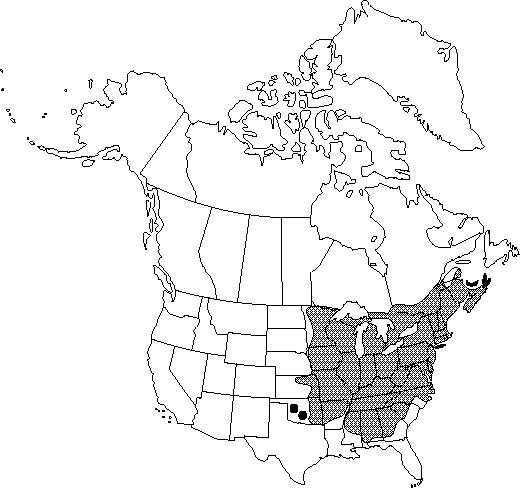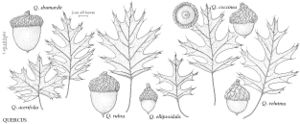Difference between revisions of "Quercus rubra"
Sp. Pl. 2: 996. 1753.
FNA>Volume Importer |
RevisionBot (talk | contribs) m (Bot: Adding category Revised Since Print) |
||
| (13 intermediate revisions by 3 users not shown) | |||
| Line 13: | Line 13: | ||
}}{{Treatment/ID/Special_status | }}{{Treatment/ID/Special_status | ||
|code=F | |code=F | ||
| − | |label= | + | |label=Illustrated |
}} | }} | ||
|basionyms= | |basionyms= | ||
|synonyms={{Treatment/ID/Synonym | |synonyms={{Treatment/ID/Synonym | ||
| − | |name= | + | |name=Quercus borealis |
| − | |authority=Michaux | + | |authority=F. Michaux |
| − | }}{{Treatment/ID/Synonym | + | |rank=species |
| − | |name= | + | }} {{Treatment/ID/Synonym |
| + | |name=Quercus maxima | ||
|authority=Ashe | |authority=Ashe | ||
| + | |rank=species | ||
}} | }} | ||
|hierarchy=Fagaceae;Quercus;Quercus sect. Lobatae;Quercus rubra | |hierarchy=Fagaceae;Quercus;Quercus sect. Lobatae;Quercus rubra | ||
| Line 30: | Line 32: | ||
}}<!-- | }}<!-- | ||
| − | --><span class="statement" id="st- | + | --><span class="statement" id="st-undefined" data-properties=""><b>Trees,</b> deciduous, to 30 m. <b>Bark</b> gray or dark gray, ridges wide, shiny, separated by shallow fissures, inner bark pinkish. <b>Twigs</b> reddish brown, 2-3.5(-4.5) mm diam., glabrous. <b>Terminal</b> buds dark reddish brown, ovoid to ellipsoid, 4-7 mm, glabrous or with tuft of reddish hairs at apex. <b>Leaves</b>: petiole 25-50 mm, glabrous, often red tinged. <b>Leaf</b> blade ovate to elliptic or obovate, 120-200 × 60-120 mm, base broadly cuneate to almost truncate, margins with 7-11 lobes and 12-50 awns, lobes oblong, occasionally distally expanded, separated by shallow sinuses, sinuses usually extending less than 1/2 distance to midrib, apex acute; surfaces abaxially pale green, often glaucous, glabrous except for minute axillary tufts of tomentum, adaxially dull green, glabrous, secondary veins raised on both surfaces. <b>Acorns</b> biennial; cup saucer- to cup-shaped, 5-12 mm high × 18-30 mm wide, covering 1/4-1/3 nut, outer surface puberulent, inner surface light brown to red-brown, glabrous or with ring of pubescence around scar, scales less than 4 mm, often with dark margins, tips tightly appressed, obtuse; nut ovoid to oblong, 15-30 × 10-21 mm, glabrous, scar diam. 6.5-12.5 mm. <b>2n</b> = 24.</span><!-- |
-->{{Treatment/Body | -->{{Treatment/Body | ||
| Line 37: | Line 39: | ||
|elevation=0-1800 m | |elevation=0-1800 m | ||
|distribution=N.B.;N.S.;Ont.;P.E.I.;Que.;Ala.;Ark.;Conn.;Del.;D.C.;Ga.;Ill.;Ind.;Iowa;Kans.;Ky.;Maine;Md.;Mass.;Mich.;Minn.;Miss.;Mo.;Nebr.;N.H.;N.J.;N.Y.;N.C.;Ohio;Okla.;Pa.;R.I.;S.C.;Tenn.;Vt.;Va.;W.Va.;Wis. | |distribution=N.B.;N.S.;Ont.;P.E.I.;Que.;Ala.;Ark.;Conn.;Del.;D.C.;Ga.;Ill.;Ind.;Iowa;Kans.;Ky.;Maine;Md.;Mass.;Mich.;Minn.;Miss.;Mo.;Nebr.;N.H.;N.J.;N.Y.;N.C.;Ohio;Okla.;Pa.;R.I.;S.C.;Tenn.;Vt.;Va.;W.Va.;Wis. | ||
| − | |discussion=<p>Trees with large nuts only one-fourth covered by flat saucer-shaped cups often are treated as Quercus rubra var. rubra; those with smaller nuts one-third covered by cup- or bowl-shaped cups are treated as Q. rubra var. borealis (F. Michaux) Farwell. While E. J. Palmer (1942) suggested that these two varieties do not, K. M. McDougal and C. R. Parks (1986) found evidence of correspondence between morphologic types and flavonoid chemotypes. This is one of the most important ornamental and timber trees in the genus.</p><!-- | + | |discussion=<p>Trees with large nuts only one-fourth covered by flat saucer-shaped cups often are treated as <i>Quercus rubra</i> var. rubra; those with smaller nuts one-third covered by cup- or bowl-shaped cups are treated as <i>Q. rubra</i> <i></i>var.<i> borealis</i> (F. Michaux) Farwell. While E. J. Palmer (1942) suggested that these two varieties do not, K. M. McDougal and C. R. Parks (1986) found evidence of correspondence between morphologic types and flavonoid chemotypes. This is one of the most important ornamental and timber trees in the genus.</p><!-- |
| − | --><p>Native Americans used Quercus rubra for a number of medical purposes, including the treatment of sores, weakness, lung problems, sore throat, dysentery, indigestion, chapped skin, chills and fevers, lost voice, asthma, cough, milky urine, hear trouble, blood diseases, and Italian itch, and as an appetizer (D. E. Moerman 1986).</p><!-- | + | --><p>Native Americans used <i>Quercus rubra</i> for a number of medical purposes, including the treatment of sores, weakness, lung problems, sore throat, dysentery, indigestion, chapped skin, chills and fevers, lost voice, asthma, cough, milky urine, hear trouble, blood diseases, and Italian itch, and as an appetizer (D. E. Moerman 1986).</p><!-- |
| − | --><p>Quercus rubra reportedly hybridizes with Q. coccinea (= Q. ×benderi Baenitz) and Q. ellipsoidalis (P. C. Swain 1972; R. J. Jensen et al. 1993); with Q. ilicifolia (= Q. ×fernaldii Trelease), Q. imbricaria [Q. ×runcinata (A. de Candolle) Engelmann], and Q. marilandica (E. J. Palmer 1948; D. M. Hunt 1989); with Q. nigra (D. M. Hunt 1989); and with Q. palustris (= Q. ×columnaris Laughlin), Q. phellos (= Q. ×heterophylla F. Michaux), Q. shumardii (= Q. ×riparia Laughlin), and Q. velutina (= Q. ×hawkinsii Sudworth).</p> | + | --><p><i>Quercus rubra</i> reportedly hybridizes with <i>Q. coccinea</i> (= Q. ×benderi Baenitz) and <i>Q. ellipsoidalis</i> (P. C. Swain 1972; R. J. Jensen et al. 1993); with <i>Q. ilicifolia</i> (= Q. ×fernaldii Trelease), <i>Q. imbricaria</i> [Q. ×runcinata (A. de Candolle) Engelmann], and <i>Q. marilandica</i> (E. J. Palmer 1948; D. M. Hunt 1989); with <i>Q. nigra</i> (D. M. Hunt 1989); and with <i>Q. palustris</i> (= Q. ×columnaris Laughlin), <i>Q. phellos</i> (= Q. ×heterophylla F. Michaux), <i>Q. shumardii</i> (= Q. ×riparia Laughlin), and <i>Q. velutina</i> (= Q. ×hawkinsii Sudworth).</p> |
|tables= | |tables= | ||
|references= | |references= | ||
| Line 48: | Line 50: | ||
-->{{#Taxon: | -->{{#Taxon: | ||
name=Quercus rubra | name=Quercus rubra | ||
| − | |||
|authority=Linnaeus | |authority=Linnaeus | ||
|rank=species | |rank=species | ||
|parent rank=section | |parent rank=section | ||
| − | |synonyms= | + | |synonyms=Quercus borealis;Quercus maxima |
|basionyms= | |basionyms= | ||
|family=Fagaceae | |family=Fagaceae | ||
| Line 62: | Line 63: | ||
|publication title=Sp. Pl. | |publication title=Sp. Pl. | ||
|publication year=1753 | |publication year=1753 | ||
| − | |special status=Endemic; | + | |special status=Endemic;Illustrated |
| − | |source xml=https:// | + | |source xml=https://bitbucket.org/aafc-mbb/fna-data-curation/src/2e0870ddd59836b60bcf96646a41e87ea5a5943a/coarse_grained_fna_xml/V3/V3_1109.xml |
|genus=Quercus | |genus=Quercus | ||
|section=Quercus sect. Lobatae | |section=Quercus sect. Lobatae | ||
|species=Quercus rubra | |species=Quercus rubra | ||
| − | |||
| − | |||
| − | |||
| − | |||
| − | |||
| − | |||
| − | |||
| − | |||
| − | |||
| − | |||
| − | |||
| − | |||
| − | |||
| − | |||
| − | |||
| − | |||
| − | |||
| − | |||
| − | |||
| − | |||
| − | |||
| − | |||
| − | |||
| − | |||
| − | |||
| − | |||
| − | |||
| − | |||
| − | |||
| − | |||
| − | |||
| − | |||
| − | |||
| − | |||
| − | |||
| − | |||
| − | |||
| − | |||
| − | |||
| − | |||
| − | |||
| − | |||
| − | |||
| − | |||
| − | |||
| − | |||
| − | |||
| − | |||
| − | |||
| − | |||
| − | |||
| − | |||
}}<!-- | }}<!-- | ||
| − | -->[[Category:Treatment]][[Category:Quercus sect. Lobatae]] | + | --> |
| + | |||
| + | [[Category:Treatment]] | ||
| + | [[Category:Quercus sect. Lobatae]] | ||
| + | [[Category:Revised Since Print]] | ||
Latest revision as of 19:33, 6 November 2020
Trees, deciduous, to 30 m. Bark gray or dark gray, ridges wide, shiny, separated by shallow fissures, inner bark pinkish. Twigs reddish brown, 2-3.5(-4.5) mm diam., glabrous. Terminal buds dark reddish brown, ovoid to ellipsoid, 4-7 mm, glabrous or with tuft of reddish hairs at apex. Leaves: petiole 25-50 mm, glabrous, often red tinged. Leaf blade ovate to elliptic or obovate, 120-200 × 60-120 mm, base broadly cuneate to almost truncate, margins with 7-11 lobes and 12-50 awns, lobes oblong, occasionally distally expanded, separated by shallow sinuses, sinuses usually extending less than 1/2 distance to midrib, apex acute; surfaces abaxially pale green, often glaucous, glabrous except for minute axillary tufts of tomentum, adaxially dull green, glabrous, secondary veins raised on both surfaces. Acorns biennial; cup saucer- to cup-shaped, 5-12 mm high × 18-30 mm wide, covering 1/4-1/3 nut, outer surface puberulent, inner surface light brown to red-brown, glabrous or with ring of pubescence around scar, scales less than 4 mm, often with dark margins, tips tightly appressed, obtuse; nut ovoid to oblong, 15-30 × 10-21 mm, glabrous, scar diam. 6.5-12.5 mm. 2n = 24.
Phenology: Flowering spring.
Habitat: Commonly on mesic slopes and well-drained uplands, occasionally on dry slopes or poorly drained uplands
Elevation: 0-1800 m
Distribution

N.B., N.S., Ont., P.E.I., Que., Ala., Ark., Conn., Del., D.C., Ga., Ill., Ind., Iowa, Kans., Ky., Maine, Md., Mass., Mich., Minn., Miss., Mo., Nebr., N.H., N.J., N.Y., N.C., Ohio, Okla., Pa., R.I., S.C., Tenn., Vt., Va., W.Va., Wis.
Discussion
Trees with large nuts only one-fourth covered by flat saucer-shaped cups often are treated as Quercus rubra var. rubra; those with smaller nuts one-third covered by cup- or bowl-shaped cups are treated as Q. rubra var. borealis (F. Michaux) Farwell. While E. J. Palmer (1942) suggested that these two varieties do not, K. M. McDougal and C. R. Parks (1986) found evidence of correspondence between morphologic types and flavonoid chemotypes. This is one of the most important ornamental and timber trees in the genus.
Native Americans used Quercus rubra for a number of medical purposes, including the treatment of sores, weakness, lung problems, sore throat, dysentery, indigestion, chapped skin, chills and fevers, lost voice, asthma, cough, milky urine, hear trouble, blood diseases, and Italian itch, and as an appetizer (D. E. Moerman 1986).
Quercus rubra reportedly hybridizes with Q. coccinea (= Q. ×benderi Baenitz) and Q. ellipsoidalis (P. C. Swain 1972; R. J. Jensen et al. 1993); with Q. ilicifolia (= Q. ×fernaldii Trelease), Q. imbricaria [Q. ×runcinata (A. de Candolle) Engelmann], and Q. marilandica (E. J. Palmer 1948; D. M. Hunt 1989); with Q. nigra (D. M. Hunt 1989); and with Q. palustris (= Q. ×columnaris Laughlin), Q. phellos (= Q. ×heterophylla F. Michaux), Q. shumardii (= Q. ×riparia Laughlin), and Q. velutina (= Q. ×hawkinsii Sudworth).
Selected References
None.
